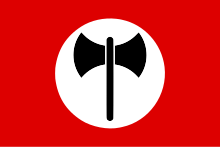Type a search term to find related articles by LIMS subject matter experts gathered from the most trusted and dynamic collaboration tools in the laboratory informatics industry.

Nazi-Maoism was a political movement and ideology that emerged in Italy around 1968,[1] with the formation of a group known as Struggle of the People. This group of students, from the Sapienza University of Rome,[2] took heavy inspiration from the writings and theory of Franco Freda,[3] and advocated for a combination of ideas from both the far-left and far-right. According to the neo-fascist group Terza Posizione, Nazi-Maoism had a stance of "neither capitalism nor communism, neither reds nor reactionary".[4] Nazi-Maoists such as Freda wanted to form a "Fascist dictatorship of the proletariat",[5] by using the Maoist guerrilla strategy of people's war to overthrow the government and the bourgeoisie.[6]
Nazi-Maoism is believed to have mostly faded away after the Struggle of the People group dissolved in 1973. Some forms of Nazi-Maoism continued in other similar groups into the late 1970s, albeit not as active as the Struggle of the People. Some slogans can be found in numerous groups of the extra-parliamentary right, such as Terza Posizione and Forza Nuova. Despite an accentuated anti-communism and nationalist positions typical of the far-right, they have a strong attention to social problems, as well as a violent anti-Americanism and anti-Zionism.[7][8][9]
| Part of a series on |
| Neo-fascism |
|---|
 |
|
|
SS-veterans Sakari Haikala and Aarne Roiha were founding members of Maoist Finland–China Society,[10] and were also members of its board.[11] Lieutenant Colonel and fascist party MP Paavo Susitaival described himself as a "Maoist fascist".[12][13] The pro-Maoist position among Finnish far-right was at least partially motivated by anti-Soviet position of Mao's China. Haikala said: "We visited the Helsinki embassy of China, and they showed anti-Russkie propaganda movies with massive cheering Chinese armies demanding attack to the USSR. We cheered also, this is the salvation of Finland. I still think that."[14] Kai Murros is a prominent neo-fascist thought leader in Finland who has identified as a Maoist.[15][16]
In France, a sister organization of the Italian Struggle of the People was called Lutte du Peuple. It was created from the remains of Giovane Europe and Jeune-Europe, which were sister organizations structured around ideas propagated mainly by Jean Thiriart. Among the founders of Lutte du Peuple were some dissident left-wing nationalists of the Ordre Nouveau and European socialists of the Pour Une Jeune-Europe (not to be confused with Jeune-Europe headed by Thiriart), directed by Yves Batille. These organizations were a mix of Thiriart's theses with a Maoism adapted to the European scene but there was a fundamental difference because while for Thiriart Maoism was a secondary element, for Nazi-Maoist organizations it was a fundamental element.[17] Nazi-Maoist ideas were noticeably manifested in the ideology of the Fédération d'action nationale et européenne.[18]
In late 2019, Ukraine's Azov movement's literature club and publishing outfit Plomin (Flame in Ukrainian), presented a translation of Freda's writings into Ukrainian. Freda's ideas were also promoted in Ukraine by neo-Nazi groups Karpatska Sich and Wotanjugend.[19]
Sister organizations were created in Italy and Germany, such as the Organización Nacional-Révolutionare Aufbau.[18]